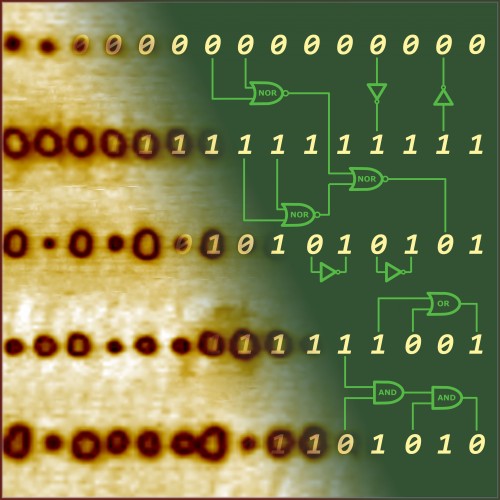
Is this a nascent memcomputer? (Courtesy: Oak Ridge National Laboratory)
By Hamish Johnston
There is a fascinating paper this week in Nature Physics about chaotic behaviour that has been spotted in a ferroelectric material. It’s an unexpected discovery that the researchers claim could lead to the development of computers that resemble the human brain.
The story begins with Anton Ievlev and colleagues at Oak Ridge National Lab in the US using the tip of a scanning probe microscope (SPM) to draw patterns on the surface of a ferroelectric material. Ferroelectrics have a spontaneous electric polarization, the direction of which can be reversed by applying an electric field.
By applying a voltage between the SPM tip and the electrically polarized surface of lithium niobate, the team was able to draw dots where the polarization is reversed. The presence of the dots could then be read back by passing the tip surface over the surface in force-microscopy mode.
This allowed the team to store binary information on the surface, with a small dot representing a “0” and a large dot a “1” for example. This worked very well when the dots were separated by about 500 nm, but when Ielev and colleagues tried to reduce this distance, something unexpected happened.
“When we reduced the distance between domains, we started to see things that should have been completely impossible,” said Ievlev. “All of a sudden, when we tried to draw a domain, it wouldn’t form, or it would form in an alternating pattern like a checkerboard. At first glance, it didn’t make any sense. We thought that when a domain forms, it forms. It shouldn’t be dependent on surrounding domains.”
The team also found that the voltage used to write the dots and the local humidity also affected the pattern formation.
You can see some of the patterns that formed in the above image. The top two rows show small and large dots that have formed in neat lines as expected. The middle row shows an alternating pattern of large and small dots that appeared and the bottom two rows are aperiodic arrangements.
After puzzling over their results, the physicists realized that they were observing chaotic behaviour. “One domain would suppress the creation of a second domain nearby but facilitate the formation of one farther away – a precondition of chaotic behaviour,” explains Oak Ridge’s Sergei Kalinin.
Team member Yuriy Pershin of the University of South Carolina adds that this sort of behaviour could be used to do “memcomputing”: a new model of computing that uses elements that both process and store information in the same location. “Memcomputing is basically how the human brain operates. Neurons and their connections – synapses – can store and process information in the same location,” explains Pershin.
With information encoded in the size of the dots, logic operations would proceed according to the rules that govern the relationships between nearby and distant dots, as illustrated in the above image.
Of course this is work in progress, so don’t bother putting a ferroelectric memcomputer on your Christmas list quite yet.
The paper describing the research is entitled “Intermittency, quasiperiodicity and chaos in probe-induced ferroelectric domain switching“.
You can read more about memcomputing in this preprint co-authored by Yuriy Pershin: “Memcomputing: a computing paradigm to store and process information on the same physical platform“.
Well this is a nice discovery. I get to work on it, in my local way. And i’wll give back you a feedback
magnetic domains are also in liquid crystals. This can be interesting to use its possible quality of store and process information in the same location. This can make for example mobile phones display of three function: store and process information and their visualisation.